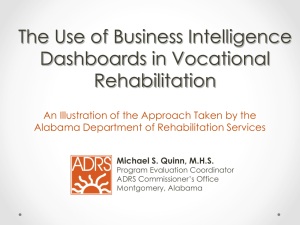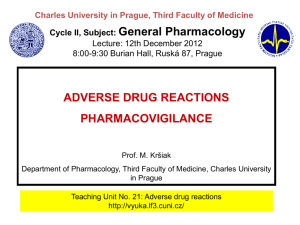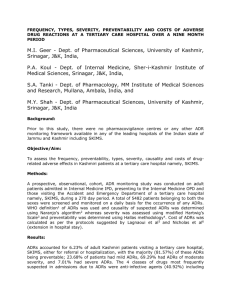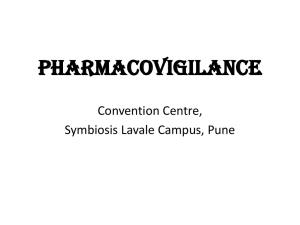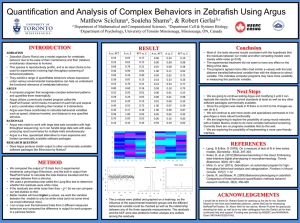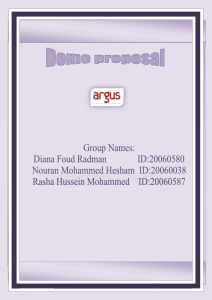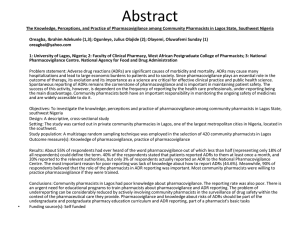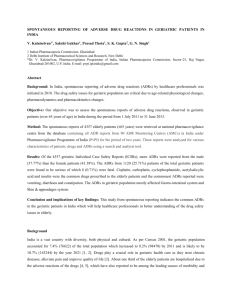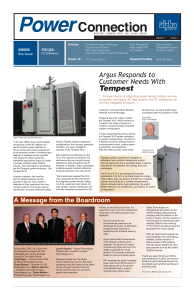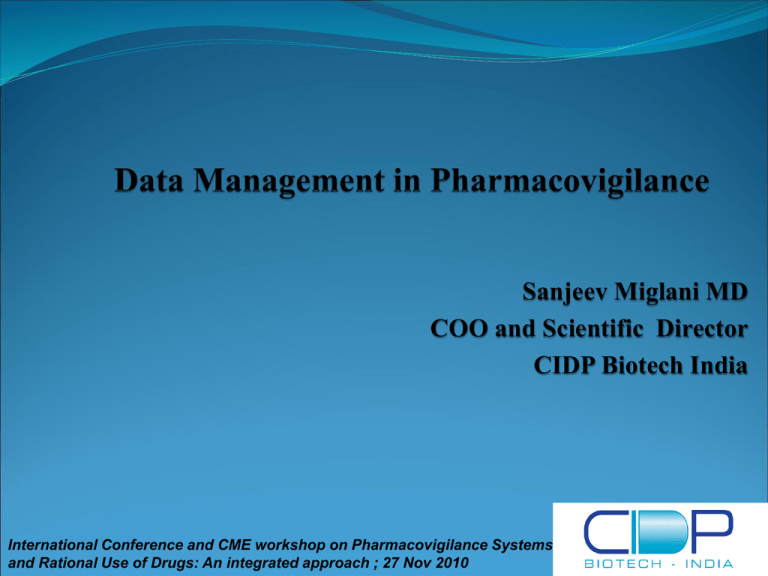
Sanjeev Miglani MD
COO and Scientific Director
CIDP Biotech India
International Conference and CME workshop on Pharmacovigilance Systems
and Rational Use of Drugs: An integrated approach ; 27 Nov 2010
Overview
Importance of Pharmacovigilance
Source of ADRs
Triage
Case Processing
Different PharmacovigilanceSoft Wares
Pharmacovigilance
Collection of the information
Processing in a Database
Medical Evaluation,
Analysis and Signal Detection
Reporting
Importance of Safety Monitoring
Capture of Complete safety data
Regulatory agencies becoming proactive
Ethical requirements
Serious consequences due to Non compliance
SOURCE OF REPORT
Spontaneous Reports
Unsolicited
communication by a healthcare
professional or consumer to a company, regulatory
authority or other organization that describes one or
more ADRs in a patient who was given one or more
medicinal products and that does not derive from a
study or any organized data collection scheme.
Literature
Each MAH is expected to regularly screen the worldwide
scientific literature by accessing widely used systematic
literature reviews or reference databases.
The frequency of the literature searches should be
according to local requirements
A copy of the article might be requested by the local
regulatory authority to accompany the report.
Solicited Sources
Solicited reports are those derived from organized
data collection systems, which include clinical trials,
registries, post-approval named patient use
programs, other patient support and disease
management programs, surveys of patients or
healthcare providers, or information gathering on
efficacy or patient compliance.
Contractual Agreements
The marketing of many medicines increasingly takes
place through contractual agreements between two
or more companies, which may market same product
in the same or different countries/region.
Arrangements vary considerably with respect to
inter-company
communication
and
regulatory
responsibilities.
Regulatory Authority Sources
Individual serious unexpected ADRs originating from
foreign RAs are subject to expedited reporting to
other authorities by each MAH.
Re-submission of serious ADR cases without new
information to the originating RA is not usually
necessary, unless otherwise specified by local
regulation.
Call Centers
A centralized office used for the purpose of receiving and
transmitting a large volume of requests by telephone.
They provide service to pharmaceutical companies with a
complete post-marketing surveillance solution including
adverse event monitoring and reporting; drug information
services; and product complaint management.
TRIAGE OF CASES
Once the complaint is received at PV department of a
company, it must be properly classified for
processing.
The initial triage should be to determine whether the
report needs urgent processing in order to be
transmitted to the RAs, or business partners.
Experienced and qualified personnel should always
supervise triage
Triage should cover, at the least, the following:
ADRs
PQCs associated with ADRs
PQCs
Medical Inquiries
legal
ADRs can further be triaged using the following
criteria:
Serious or non serious
Expected or unexpected
Causality (Specially for SAEs from Clinical Trials)
The minimum information required for
reporting purposes is:
An identifiable patient
the name of a suspect medicinal product
an identifiable reporting source, and,
an event or outcome that can be identified as serious and
unexpected and for which, in clinical investigation cases,
there is a reasonable suspected causal relationship.
Case Processing
Data entry into safety database
Medical coding
QC review
Medical review
Data Entry:
For user friendliness, the front end of these software are
made in such a way that end user can enter data very
easily and more accurately.
These systems generally require additional mandatory
fields like date of receipt of ADR, Source Country, type of
source.
Once the case with minimum information for reporting is
entered, the case is saved
Information can be divided into following fields,
Subject (data related to subject like name or initials,
height, weight, gender, age ,pregnancy etc)
Suspect Drug (data relate to suspected medicinal
product like name, start date, end date, duration of
exposure, formulation, dose and dosage form,
indication etc),
Event (which includes fields like, reporter’s verbatim,
company’s verbatim, MedDRA terms, event onset date,
event end date, etc).
Reporter’s information may include (reporter’s name,
contact address, phone number, e-mail id, whether
reporter is a Health care professional or not, secondary
or tertiary reporter, etc),
Reportability or submission fields may include country
where the case is reportable, schedule of reports,
including due date of submission, etc)
Narratives
The objective of the narrative is to summarize all relevant
clinical and related information
The narrative should serve as a comprehensive, standalone “medical story”.
The information should be presented in a logical time
sequence; ideally this should be presented in the
chronology of the patient’s experience, rather than in the
chronology in which the information was received.
MedDRA
Coding of:
– Adverse events
– Medical history
– Signs and symptoms
– Diagnoses
– Physical examination data
– Laboratory tests
WHO-DD
The WHO Drug Dictionaries consist of medicinal product
names - both proprietary and nonproprietary - from more
than 90 countries.
All drugs in the WHO Drug Dictionary and the WHO Drug
Dictionary Enhanced are classified according to the
Anatomical Therapeutic Chemical classification – ATC.
FOLLOW-UP INFORMATION
All efforts should be made to seek additional information
for good assessment of case
The priority of cases for follow-up should be as follows:
Serious and unexpected,
Serious and expected, and
Non-serious and unexpected
In addition to seriousness and expectedness as criteria,
cases “of special interest” also deserve extra attention as
a high priority
QC Review
After Data entry, a drug safety specialist
reviews the data entry against the source
documents and reviews the case narrative.
A clear methodology on the quality check
should be developed
Follow-up information should be requested
when the initial case is incomplete or unclear.
Medical Review
The medical review should generally cover the
medical content of the case with particular attention
paid to the narrative, the suspect and concomitant
drugs (including dosages), the past medical history,
and coding.
The review should also include, but is not limited to,
the following considerations:
•Is a diagnosis possible?
•Have the relevant diagnostic procedures been
performed?
•Were alternative causes of the reaction(s) considered?
•What additional information is needed?
.
Tracking and Metrics
It is critical that all cases reports be tracked
The tracking of cases should base on the
workflow step
Each drug safety specialist and manager should
be aware of status of all the cases
The manager can reallocate cases or other work
to ensure that the time-critical cases are handled
appropriately.
Similarly, non expedited cases that need to be
completed for aggregate reports should be
tracked so that they are completed by the time of
data lock.
Line Listings: Example
Mnf Ctrl
#
Ctry
Srce
Sex
AgeYr
Dose
Treatme
nt dates
Onset
React ion
Outcome
Comment
s
HCP
M
24
50mg
25 to 27Aug2009
25AUG2009
Abdominal
pain
Recov
ered
Hospitalised.
LIT
F
41
25mg
26 to 29August
2009
26AUG2009
Elevated
LFTs, swollen
abdomen,
Unkno
wn
Abnormal on
ult rasound
liver,
gallbladder,
pancreas.
Gastric disorders
CLINI00
IND
Hepatic disorders
951114
USA
Vigiflow
Safety data Base is hosted by the Uppsala Monitoring Center
Internationally recognised standards
–E2B report format
–WHO-ART and ICD or MedDRA
–WHO Drug Dictionary
One server installation –maintained in UMC
Oracle's Argus Safety suite
Oracle Argus Affiliate: local affiliates and among partners,
lowering risk from unanticipated reporting delays.
Oracle Argus Interchange: Electronic exchange
Oracle Argus Reconciliation: SAE reconciliation
Oracle Argus Dossier: Periodic safety update report
Oracle Argus Insight: Multidimensional analysis of drug safety
data. It can generate preformatted filterable safety reports
Oracle Argus Perceptive: an integrated solution for signal
management.
Aris G Safety Soft ware Suite
ARISg™: Used for the Collection, coding, Assessment and
Reporting of Adverse events data
ARISj™: Japanese pharmacovigilance system
agXchange ESM™: Electronic exchange
agXchange IRT™: Inbound receipt and triage of ADRs
agConnect™: Clinical safety reconciliation system
agComposer™:Comprehensive periodic and aggregate
reporting system
agSignals™:Advanced signal detection and data mining system



